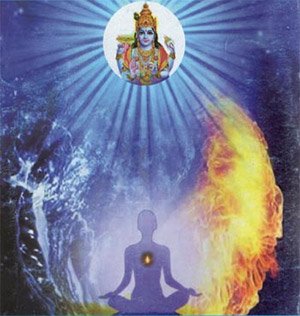Siddhanta Sangraha of Sri Sailacharya
by E. Sowmya Narayanan | 2008 | 30,562 words
Siddhanta Sangraha Chapter 23 (English translation), entitled “the vibhavavatara” as included in the critical edition and study. The Siddhanta Samgraha is a Sanskrit philosophical text dealing with Vishishtadvaita in five hundred Sanskrit verses. It was written by Shri Shailacarya (18th century) and closely follows the philosophy of Vedanta Deshika (13th century).
Chapter 23 - The Vibhavāvatāra
203. When there is conflict between the śrutis and smṛtis, it is only the śrutis that are valid and smṛtis should not be taken into account. This has been stated by the Brahmasūtrakāra himself. The incarnation of the Supreme Lord with His auspicious qualities is stated as pure creation (suddha sṛṣṭi). That is, the incarnation supported by the pure sattva guṇa without the mixture of rajas and tamas.
204-205. Whereas, the creation of the bound souls (baddhas) who possesses the body with the mixture of three qualities and also with good and evil deeds is known as mixed creation (miśra sṛṣṭi)
There is also another type of incarnation of the Lord, namely, ‘anupraveśa avatāra’, which is favourable to the jñāna and vidyā and mentioned in Śrīmad Rahasyatraya Sāra, its commentary and in Pāñcarātra texts.
Conclusion:
 This concludes The Vibhavavatara according to Vishishtadvaita philosophy explained by Shri Shailacarya. This book follows the model of Vedanta Deshika although the Vishishta Advaita school was originally expounded by Shri Ramanuja. Vishishta-Advaita is one of the various sub-schools of Vedanta which itself represents one of the six orthodox schools of Hindu Philosophy. They highlight the importance of the Upanishads, the Bhagavad Gita and the Brahma Sutras.
This concludes The Vibhavavatara according to Vishishtadvaita philosophy explained by Shri Shailacarya. This book follows the model of Vedanta Deshika although the Vishishta Advaita school was originally expounded by Shri Ramanuja. Vishishta-Advaita is one of the various sub-schools of Vedanta which itself represents one of the six orthodox schools of Hindu Philosophy. They highlight the importance of the Upanishads, the Bhagavad Gita and the Brahma Sutras.
